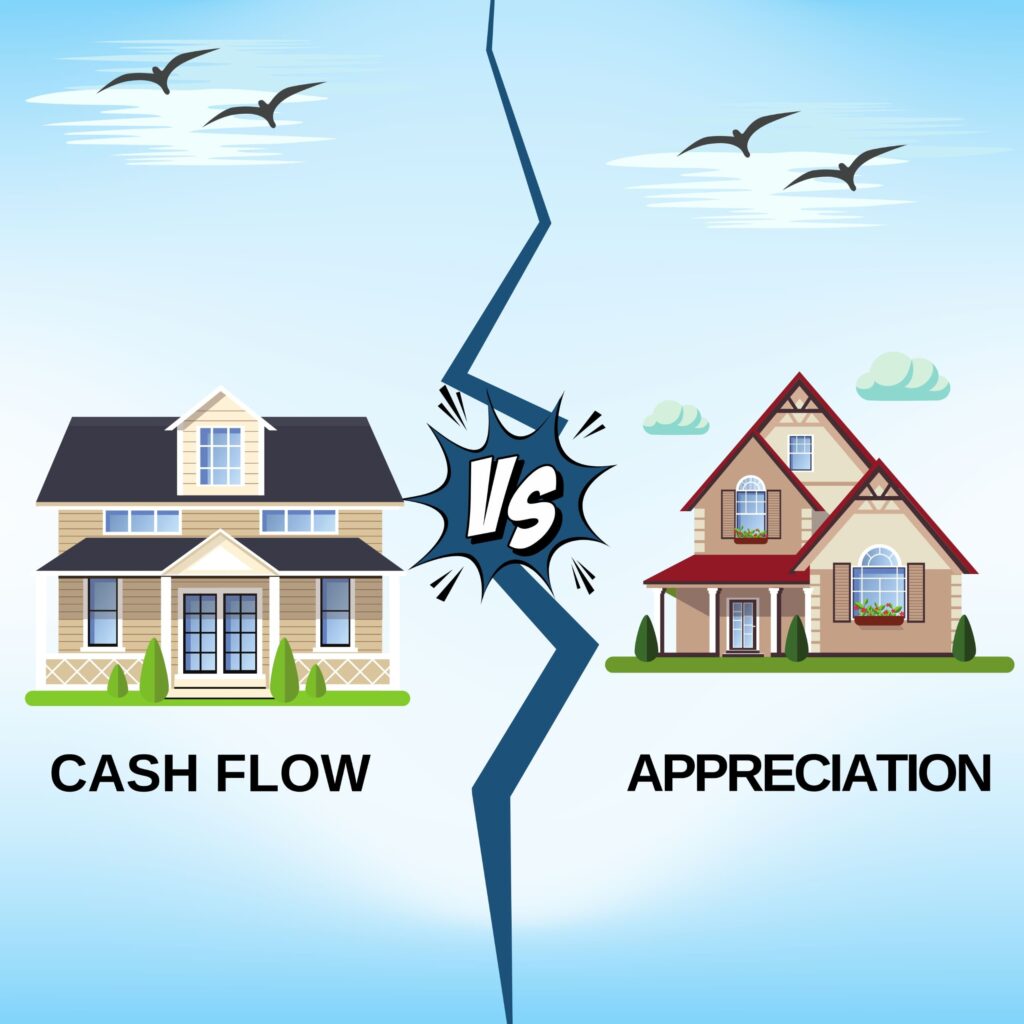When diving into real estate investing, one of the most important decisions you’ll face is choosing between two fundamental strategies: cash flow and appreciation. Both have their merits, and the best choice often depends on your financial goals, risk tolerance, and investment timeline.
In this guide, we’ll break down the differences between these two strategies, explore their pros and cons, and help you determine which path aligns with your objectives.
Definition of Cash Flow vs. Appreciation

- Cash Flow: Cash flow refers to the income generated from a property after accounting for all expenses, including mortgage payments, taxes, insurance, and maintenance costs. Properties generating positive cash flow provide consistent income streams, often from rental payments.
- Appreciation: Appreciation is the increase in a property’s value over time. This strategy focuses on buying properties in areas poised for growth, allowing investors to profit by selling at a higher price later.
While both strategies involve real estate, they cater to different investor goals—one emphasizes short-term income, while the other prioritizes long-term value growth.
Cash Flow Strategy vs. Appreciation Strategy

Cash Flow Strategy
- Target Properties: Typically, investors seeking cash flow prioritize multi-family homes, single-family rentals in affordable neighborhoods, and properties in established rental markets.
- Focus on ROI: The key metric for cash flow investors is return on investment (ROI), calculated by comparing rental income to property costs.
- Stability: A cash flow strategy provides financial stability, making it ideal for investors seeking steady, predictable income.
Appreciation Strategy
- Target Properties: Appreciation-focused investors look for properties in areas undergoing development, with strong population growth, or in desirable locations.
- Focus on Equity: The emphasis is on building equity as property values rise over time.
- Growth Potential: This strategy is better suited for investors willing to take risks and wait for long-term market trends to pay off.
Long Term for Cash Flow & Appreciation Investment

Cash Flow Investments
- Benefits: Over the long term, cash flow investments offer a reliable income stream that can grow with inflation and rent increases. These properties often perform well during economic downturns, as rental demand tends to remain steady.
- Challenges: The downside is that cash flow properties might not see significant appreciation. They are best for investors seeking financial security rather than large capital gains.
Appreciation Investments
- Benefits: Over time, appreciation properties can deliver substantial returns as their value increases. Investors may also benefit from tax advantages, like capital gains exclusions or deferred taxes via 1031 exchanges.
- Challenges: Appreciation is less predictable and heavily influenced by market trends, interest rates, and economic cycles. Investors may face periods of stagnation or even declining property values.
How Lenders Evaluate Cash Flow vs. Appreciation

When applying for financing, lenders view cash flow and appreciation differently:
Cash Flow
- Focus on Rental Income: Lenders assess the property’s rental income potential to determine whether it can cover mortgage payments and other expenses.
- Debt Service Coverage Ratio (DSCR): A common metric lenders use to evaluate cash flow properties. A DSCR above 1.2 (income exceeds expenses) is typically required.
Appreciation
- Focus on Borrower’s Profile: For properties with appreciation potential but little cash flow, lenders rely more heavily on the investor’s financial health, credit score, and other assets.
- Market Analysis: Lenders may consider local market conditions and growth trends to gauge the likelihood of future value increases.
Exit Strategies for Cash Flow vs. Appreciation

Cash Flow Exit Strategies
- Hold and Rent: Many cash flow investors keep properties indefinitely, relying on rental income for retirement or reinvestment.
- Sell to Other Investors: Properties with a strong cash flow history are attractive to other investors, allowing for a smooth sale.
Appreciation Exit Strategies
- Sell at Peak Value: Appreciation investors often aim to sell during favorable market conditions to maximize profits.
- Leverage Equity: Investors can use equity from an appreciated property to finance additional purchases or fund other ventures.
- 1031 Exchange: Many appreciation-focused investors defer taxes by reinvesting proceeds into another property through a 1031 exchange.
Which Strategy is Right for You?
The choice between cash flow and appreciation depends on your financial goals and investment style:
- Choose Cash Flow If: You want consistent monthly income, prioritize stability, and have a lower risk tolerance. Cash flow properties are ideal for those seeking to replace their income or build passive wealth over time.
- Choose Appreciation If: You’re focused on long-term wealth growth, are comfortable with market risks, and have the financial flexibility to wait for returns. Appreciation properties are ideal for investors looking to build equity and achieve large capital gains.
Final Thoughts
Both cash flow and appreciation are powerful real estate strategies, but they serve different purposes. Some seasoned investors even combine both approaches by diversifying their portfolios, balancing cash flow properties for stability with appreciation properties for growth.
As you explore the market, take time to evaluate your goals, timeline, and risk tolerance. With the right strategy, you can make the most of real estate’s potential to create lasting wealth.
Looking to learn more about real estate investing? Visit our blog for expert insights and actionable advice to help you succeed!


